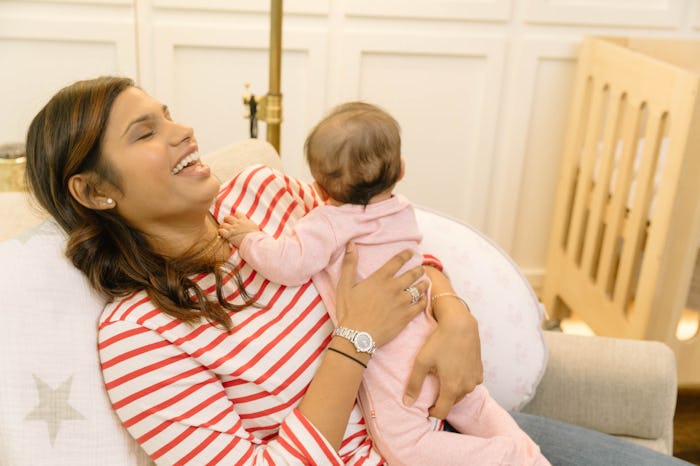Life
Literally Everything You Need To Know About Your Baby's Sleep Schedule & DST
Babies love routines, and a steady one can help them feel secure and stay healthy. Schedules teach kids that the world is a safe, predictable place — sleep schedules in particular are of the utmost importance for family harmony. Biologically, sleep is particularly important for the very young, whose brains are still growing and developing. Personally, I'm convinced my 1-year-old practices walking in her sleep, squirming and caterpillaring around the crib. (Of course, she could also be rehearsing a bank heist.) So should you keep your baby's same sleep schedule when daylight saving time ends?
"In a perfect world, you should stick to your baby's sleep schedule despite the changing clocks," explains Kelsey Allan, mom to an 11-month-old and a sleep expert with Sleep Train. She goes on to note that our bodies — both adults and children — thrive on schedules. So in a perfect world, we wouldn't change our sleep schedule for any reason, weekends and holidays included. However, we don't live in a perfect, schedule-free world. "The reality is that parents have to shift their baby's schedules with daylight saving time to accommodate childcare, work, and other obligations," notes Allan. So how do you go about shifting that schedule in our time-crunched existence?
According to Steve Silvestro, MD, maker of the podcast The Child Repair Guide, your best course is to know your child's personality, and plan accordingly. A flexible, adaptable child might not mind a switch in schedule. But most children, Silvestro notes, just won't feel tired at a new bedtime — and may be exhausted when you wake them in the morning (or when they wake you). He recommends starting two weeks in advance of "fall back," and pushing bedtime back by 10 to 15 minutes every three days.
Dr. Sujay Kansagra, pediatric neurologist and Mattress Firm’s sleep health consultant, also recommends the slow-burn approach. "Start early," he tells Romper in an email. "Leading up to the time change, slowly move your child’s nighttime routine and bedtime later by 10 minutes each day and wake them 10 minutes later than normal." Kansagra also advises avoiding light in the morning on these transition days. "If you’re trying to help them wake and sleep later, avoiding the light will help them to adjust faster," he explains. Additionally, consider breaking some bedtime rules in the days leading up to the switch. Kansagra notes:
"Normally, the typical recommendation is to avoid extra light at nighttime, but during these next few days your children have a pass. Some extra light at night can help their internal body clocks adjust to the later bedtime."
Lastly, Kansagra wants parents to know that when they change a baby's sleep schedule, you shouldn't forget about mealtimes. "Food intake can help set the body clock’s timing," he writes. So adjust your child's eating schedule just as you adjust her bedtime and wake times.
If you're anything like me, you totally forgot about daylight saving time ending this weekend, and don't have two weeks to prepare. But any adjustment is better than none. So, tonight, put your child to bed 15 minutes early, and tomorrow, do the same. Mathematicians will notice this doesn't make the full hour, but as Allan notes, "Even these small increments can cause trouble if your child is especially sensitive about bedtime, so you won't want to take your chances waiting until the night of the time change to shift the routine by a full hour." Allan also recommends starting a week or two in advance, which I certainly will (try to) remember for next year.
So yes, you should change your baby's sleep schedule for the end of daylight saving time. Ideally, the process takes weeks, but many of us are down to the wire this weekend. For myself, and all the other forgetful parents out there, I'd like to say, good night, and good luck.
Check out Romper's new video series, Romper's Doula Diaries:
Check out the entire Romper's Doula Diaries series and other videos on Facebook and the Bustle app across Apple TV, Roku, and Amazon Fire TV.
